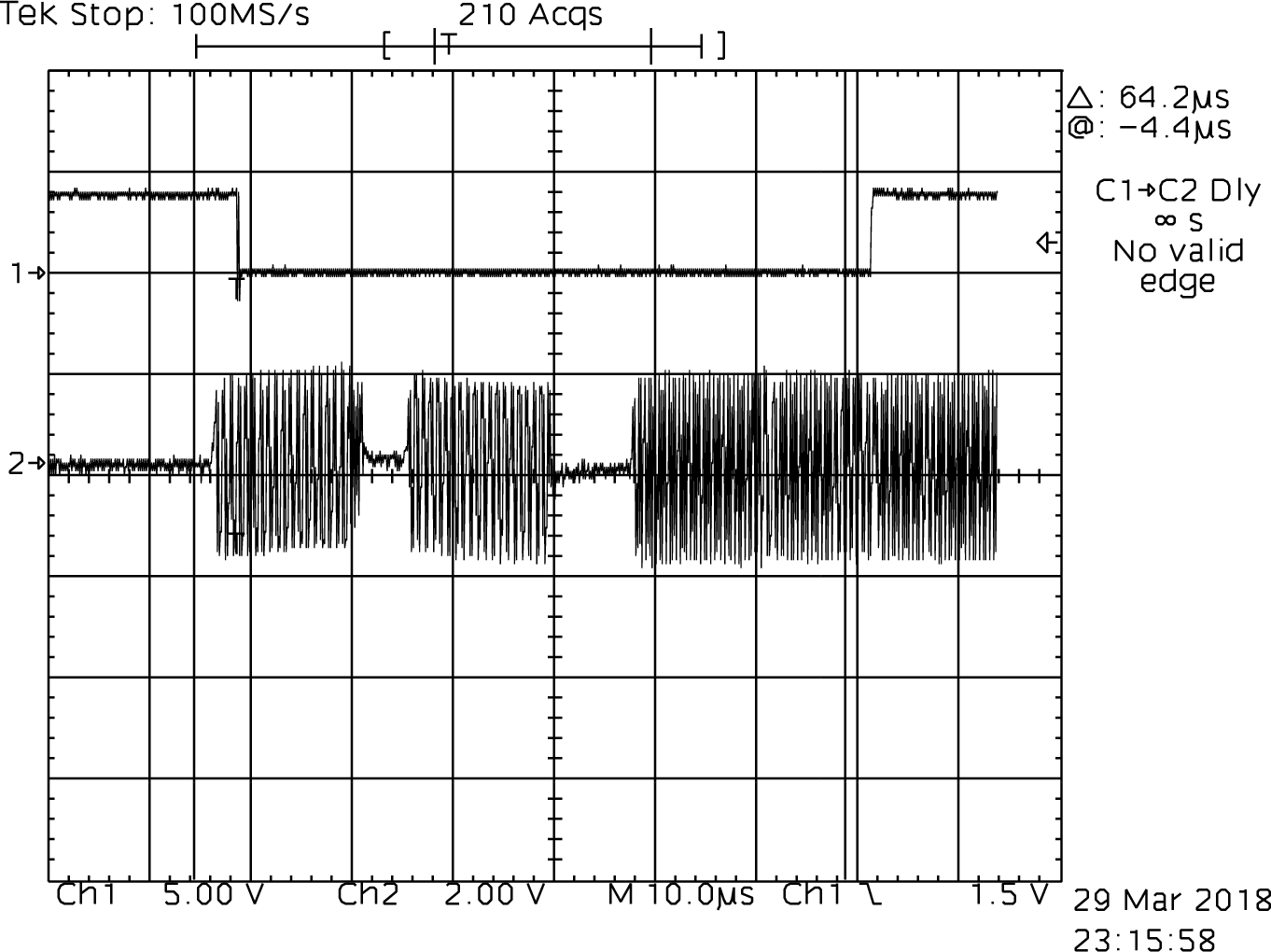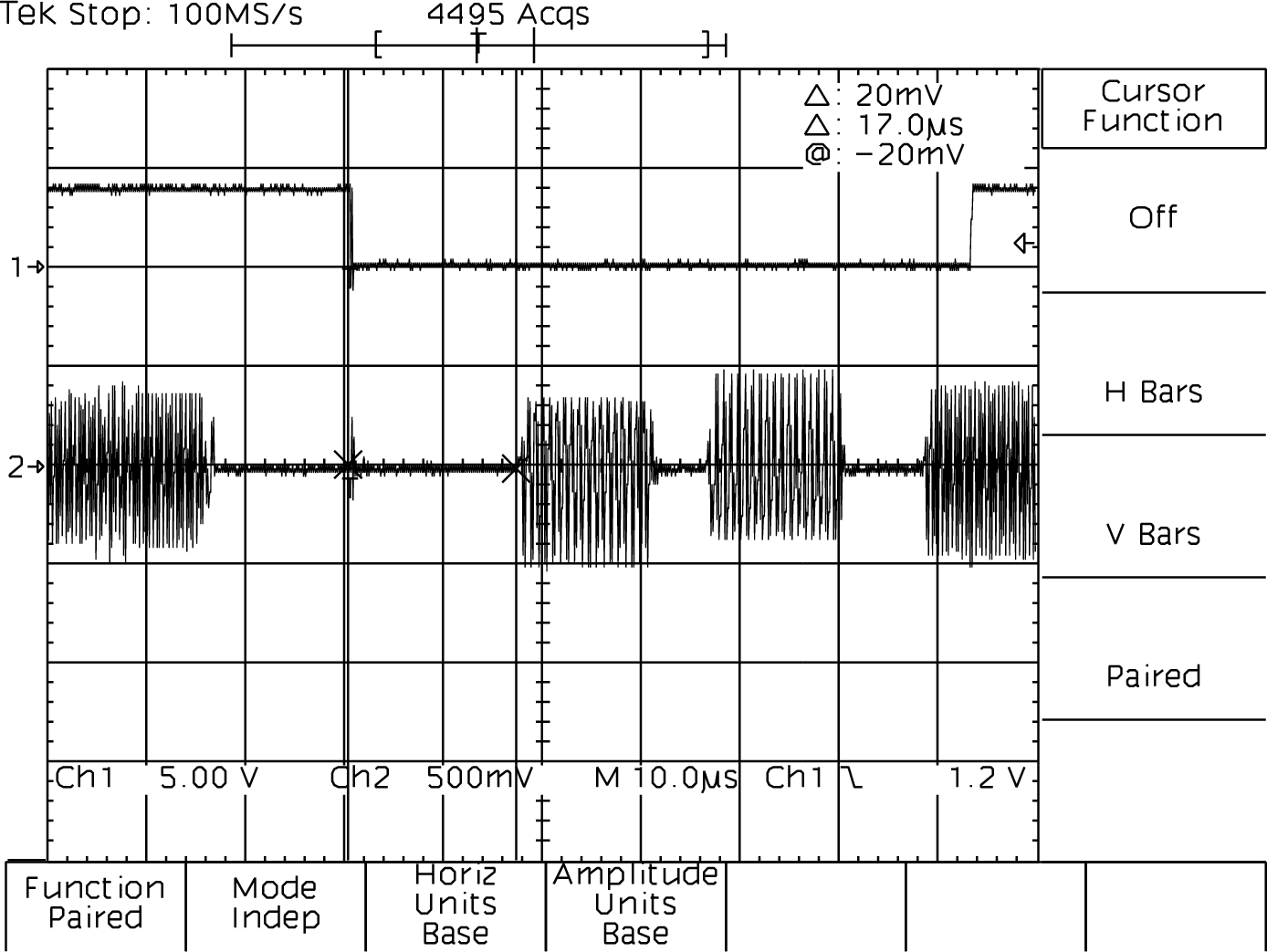Have I found the problem with my RL02 Drives?
Today my new scope arrived - TDS420A. I am now able to measure waveform timings with a fair degree of accuracy, which is something my old 20MHz scope didn't allow me to do.
While it sounds terrible, the RL02 Technical Descriptions manual is a joy to read. It contains so many details missing from the standard RL02 technical manual. Everything is explained very clearly.
Below I will post the screen dumps from my scope for common RL02 problem finding steps in aforementioned RL02 manual, in the hope that I will be able to find the fault.
Sector Transducer Output

The manual states that the voltage between 0V and a peak should be between 0.35V and 1.5V. Very roughly the voltage of my sector transducer appears to be around 1V. The manual also states that the time between each sector pulse should be between 594µS and 639µS. Perhaps mine is spinning very slightly on the fast side at 640µS, but I doube this is the issue. Let's move on…
Sector Pulse Timing

I believe the sector pulses are generated not from the servo burst data, but from the sector transducer. The manual states that the time between a fall and rise of this signal should be 625µS. My scope is telling me that this is 624µS. I don't think we can do much better than that, but if we can, it's likely due to the platter spinning very slightly too fast.
Servo Bursts and Sector Timings

This one gets more interesting. On my old scope, I was unable to see if there was a problem with this or not. According to the manual, there should be a 15µS +/- 3µS delay between the falling edge of the sector pulse and the start of S1 servo data. Clearly, on my drive, the sector pulse is far too late. This may explain why I am unable to read or write to the drive - it cannot keep track of the which sector the head is flying above.
The steps to correct this do not appear to be too complicated (radial alignment), and can be found on page II/3-11 of the technical description manual. I am too tired to try this tonight, and I really don't want to slip up and cause damange to my only RL02 cartridge. I will try this tomorrow. Whether it works or not, I will update this post. If it doesn't work, I will continue with the other testing procedures. However, the next one is head alignment - which according to the beginning of this manual, is not critical to the operation of the drive. On an RL02, head alignment simply reduces the searching time when switching between heads / sides of the platter.
Wish me luck…
<2018-03-30 Fri 14:06> Okay, I have performed the radial alignment. It's looking much better now.

However, the drive still does not working. If I disable the Seek Timeout Error (SKTO) the heads load, detect the outer guard band (S1 bursts only), and then move onto track 0. The heads remain on track 0 perfectly. Before, the heads would jitter trying to stay locked onto the track, which also resulted into the READY lamp flashing. So, the radial alignment fixed this part. However, the drive will not accept commands while the SKTO error is disabled. This makes me suspect that perhaps the heads are not loading fast enough. Perhaps it is a mechanical issue and the servo is a bit dry? I'll ask the mailing list for their thoughts.
<2018-03-30 Fri 17:07> Okay it isn't the servo motor. I changed it to another one and the same problem seems to exist. Starting to run out of ideas. I've received a couple of suggestions, one of them being to check timing caps, but the timing is provided by the 4.1MHz signal provided by the RLV12. It is not possible to spin up an RL02 cartridge without this timing data.
<2018-03-31 Sat 01:38> I have been scanning the RL02 and RLV12 technical manuals for details about the communication between the controller and the drive. From what I can tell so far, only the timing pulses should be needed for the heads to seek to the first track. I am therefore going to assume for the time being that the RLV12 controller is fine.
Out of desparation, I am beginning to wonder if I have done something something silly, like had the r/w amplitude set too high at some point in the past. The output of this will be fed into several TTL logic gates, and it isn't unlikely that I have exceeded 5V at some point. So, let's take a look at the circuit diagrams.

The output of the heads are fed into the LM733 op-amp E9, the variable resistor which I adjusted is R40. The amplified signal is visible at testpoint TP2. However, this signal makes its way into pin 1 of E5 and pins 1 and 11 of E8. I will have to check their outputs tomorrow. So I should check output of 4 and 9 or E5 and E9.
<2018-03-31 Sat 11:24> Both E9 and E5 are responding to their inputs in a normal way… Running out of ideas. Might attach logic analyzer to the ribbon cable between the RLV12 and RL02 later today.
<2018-03-31 Sat 23:30> I hooked up the ribbon cable to my logic analyzer today. It was quite interesting to see the MFM data being transmitted. Additionally, selecting the drive would change the correct bits on the bus. This gives me some confidence in my terminator, but perhaps there is still something wrong with it. At this point, I'm fairly sure that the drive is fine. This leaves either the RLV12 controller, the ribbon cable or the terminator.

However, the drive would not spin up if it is not detecteing the system clock (4.1MHz +/- 0.1%). So I don't see why any of the head loading circuitry would be any different. Additionally, no drive commands are transferred from the PDP-11 during the initial head load, so as long as it has the system clock, that should be all that is needed. This makes me think the terminator and controller, are fine, at least fine enough to load the heads. This is perhaps confirmed even further by the heads loading fine when Seek Timeout is disabled.
What is wrong with you, RL02 drive?!
Related posts:
Wanting to leave a comment?
Comments and feedback are welcome by email (aaron@nospam-aaronsplace.co.uk).